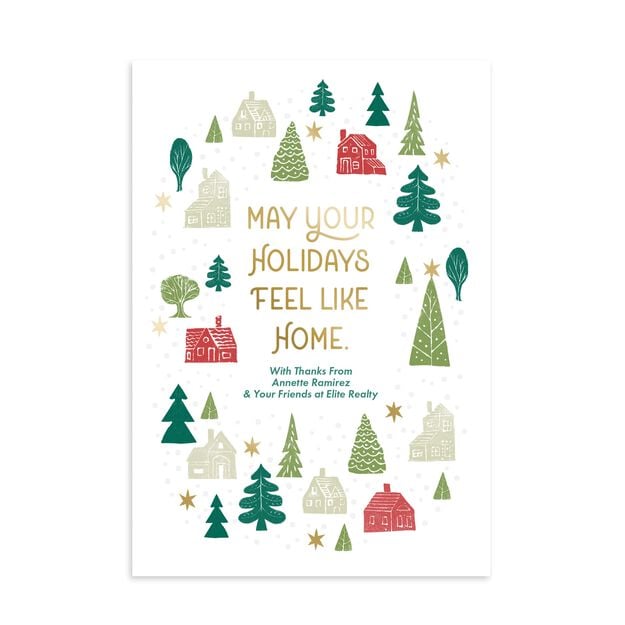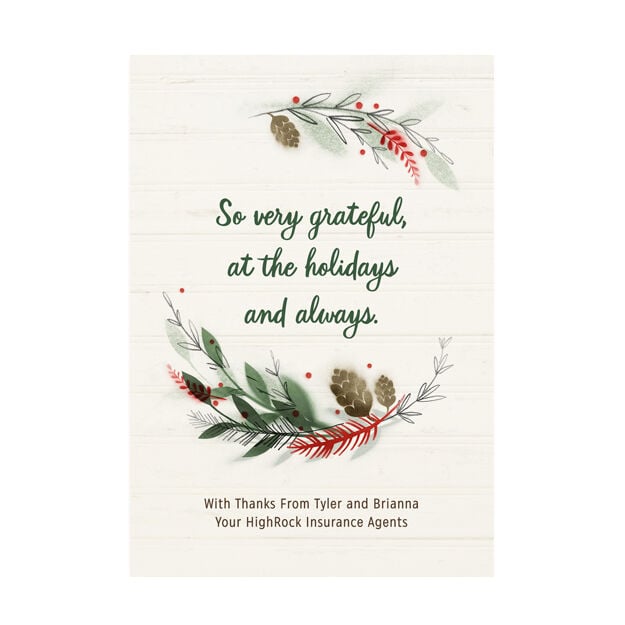Greeting Card Marketing: Powerfully Persuasive in a High-Tech World

Harnessing the Power of High Touch Over High Tech
We might live in a digital world, but some of our most important interactions are offline. Say, spending time with friends at a local coffeehouse. Playing with our kids in the park. And yes, receiving mail.
Nothing quite compares to the act of going to the mailbox to find a greeting card. Because it’s fun and often surprising, it doesn’t feel intrusive. As a result, we eagerly open cards, even if they’re from businesses rather than individuals. Why? Above all else, we’re curious. Plus, we’ve been conditioned socially to see mailed greetings as warm, inviting, and sincere.
Companies looking for ways to recharge their marketing need to take notice of these behavioral trends. It’s true that most people don’t think of greeting cards as a direct mail tactic. Yet cards can play the role of consumer-brand relationship nurturers. As noted in a research project between Dr. Stephen Lind of the University of Southern California and Hallmark Business Connections, greeting cards evoke emotional connections and trust between buyers and sellers.
Even in the online era, it’s tough to get more than 40% of customers’ email addresses. By contrast, it can be much easier to secure 100% of their physical addresses. That makes it simple and cost-effective to deliver messaging that’s not seen as spam and is likely to be opened by nearly everyone. Perhaps that’s why Lind’s study shows that around one-third of all businesses send physical cards during the year-end holidays.
Greeting cards are more than a savvy touchpoint during festive seasons. They can be a year-round revenue generator as well as a compelling and measurable addition to any marketing campaign.
Embraced and Open: A Study on National Business Greeting Card Trends
Hallmark Business Connections collaborated with Lind on a research study that measured national business greeting card trends as the world continues to seek valuable connections following the COVID-19 pandemic. Here are a few highlights:
Businesses predominantly sent physical cards through the mail (87.6%), but many businesses report sending e-cards as well, with a total of 29.5% using e-cards either independently or in conjunction with physical cards.
The majority of cards sent by U.S. small businesses are related to the winter holidays: Only 16% report sending cards before Thanksgiving, and 64.3% specify they sent cards in the weeks before Christmas.
Nearly all (91.4%) of small businesses that send greeting cards send them to current customers. Past customers are the second-largest group of recipients, receiving cards from nearly two-thirds (65%) of small businesses. Additionally, 39% of small businesses report sending cards to potential customers.
Making Marketing Inroads Through a Time-Honored Medium
Marketers appreciate having numerous ways to contact prospects and customers. Greeting cards offer the chance for brands to boost customer relationships while simultaneously delivering an attractive return on investment of up to 38-to-1 (depending on the format and campaign type). So what makes mailed greeting cards such high-performing marketing tools?
1. They can augment other marketing methodologies.
Although greeting cards can be delivered at traditional times of the year, such as during the holidays, they can be leveraged as stand-alone resources during milestone moments. A good example of this is the Hallmark Customer Care platform. Customer support representatives can log in to the platform to send greeting cards when customers tell them about difficulties during their interactions. This generates a unique, positive, and “free-floating” moment between the company and customer that’s unbound by any campaign.
Over time, these spontaneous moments can add up to stronger bonds between buyers and brands. According to Fundera, 90% of direct mail 2 is opened by recipients. And our Hallmark Business Connections clients have told us about three-quarters of the people who receive greeting cards from them feel a stronger, more positive connection with their businesses.
90% of direct mail gets opened.
2. They can encourage online and offline chatter.
Getting a greeting card with the perfect message is a shareworthy surprise. Many times, customers will be so happy to receive birthday and anniversary cards that they’ll post them on their social media pages. Some will go a step further and tag the company or make a special hashtag. This generates a ripple effect, giving the outreach momentum beyond its original intent.
In the same vein, people hold onto their greeting cards and display them in their homes. Whereas a customer would never show off a sales-heavy flyer or postcard, the customer eagerly might add a business’s holiday card to a personal display on a living room mantel or office desk. Again, this allows the company to get extra exposure.
3. They can be used to build friendships between sales representatives and clients.
Sales professionals are always seeking innovative ways to connect with their contacts. Sending greeting cards during a consumer’s important life moments can forge tight ties. As one article noted 3 , customers who feel a kinship with a salesperson are 12 times more apt to buy. Is it any wonder that according to Lind’s study, 91.4% of small companies that send greeting cards focus their attention on current clients?
Over time, salespeople who consistently remember their clients’ special days can differentiate themselves and their companies. They can also use greeting cards as a secondary way to solidify messaging sent via other means (such as email, text, or direct messages).
Customers who like their sales rep are 12 times more likely to purchase.
4. They can heighten branding efforts.
Every organization has an overarching brand image and culture, and greeting cards can help reveal and celebrate the personality of a brand. For instance, Lind says that nearly 6 out of 10 companies choose traditional content for the tone of their greeting cards 4 . Consequently, those brands are aligning themselves with classic traits and content.
This type of branding isn’t lost on consumers. A full 82% of those who receive Hallmark cards feel a stronger understanding of the sender’s brand, according to client anecdotes.
Improving Employee Engagement/Satisfaction Through Greeting Cards
Greeting cards aren’t just strong ways to bump up marketing ROI. They’re also proven vehicles to keep employees engaged for several reasons:
HIGHER SALES: Employees who send Hallmark greeting cards retain 16% more customers than their counterparts.6 They also see 10% lower attrition among buyers.
HIGHER NET PROMOTER SCORES: Many employees are evaluated on their and the company’s customer satisfaction scores. Hallmark Business Connections clients have reported up to 25% higher buyer satisfaction.
HIGHER EMPLOYEE SATISFACTION RATINGS: We’ve seen that employees who have been empowered to send greeting cards as needed to customers report an 18% bump to their on-the-job satisfaction rates. Typically, employee happiness has a direct correlation to customer happiness, too, per Aon.
Maximizing the Impact of Greeting Card Campaigns
According to the United States Postal Service, roughly two-thirds of people said that they feel special when they receive greeting cards 9 . By comparison, only 5% said a text gave them the same sense of delight. Of course, this doesn’t mean companies should send out greeting cards without plans. The way to make the most of any greeting card campaign is to put two tactics into motion:
Understanding the Customer
All greeting cards will not resonate with all audiences. For example, a design and message have to match not only the corporate brand, but also the preference of the receiver. That’s where thought and research come into the picture. Some companies use social listening tools to understand the language and sentiments most important to their target audiences. They might also seek input from customer care surveys or service representatives to get the tone just right.
Knowing When to Send a Card
Life event marketing is all about remembering customers during the most important times in their lives — think birthdays, holidays, adoptions, weddings, and anniversaries. Certainly, life event marketing can take time to plot given that all customers will be on different timelines. However, once a life event marketing strategy is put into action, it can be updated quickly.
‘Happy Holidays’ or ‘Merry Christmas’ — Which Greeting Serves You Best?
Among American small businesses that send greeting cards to customers, the vast majority concentrate their efforts during November and December. Yet they don’t all prefer the same announcement in advance of the biggest holidays of the year.
Lind’s research uncovered an interesting disparity in language involving holiday-related greeting cards.

Specifically, 47% chose a “merry Christmas” wish, whereas 51.6% opted for “happy holidays,” and 44% preferred “season’s greetings.”
Regardless of whether the well-wishes were specific or generic, fewer companies relied on religious artwork — even those that sent “merry Christmas” mail.
What does this mean for businesses jumping onto the greeting card trend bandwagon? It’s yet another reason for them to understand their brand and audiences in order to pick the ideal holiday wording to match everyone’s needs.
Greeting Cards Belong in Everyone's Mailbox - Even Gen Z's!
There’s been a bit of a misunderstanding about younger generations and greeting cards that needs to be cleared up. Even though the younger generation might not send out as many cards, they still love to receive them from family, friends, and yes, even businesses.
According to research from the Greeting Card Association, Millennials spend more of their disposable money on greeting cards than Baby Boomers. 11 To be fair, Baby Boomers buy cards in greater quantities, but they don’t spend as much per card as Millennials do. And Millennials sure love their cards! About three-quarters of them told the USPS they’d like to receive more. 12
Currently, Generation Z is just entering the workforce. As this generation ages up and begins taking on more responsibilities, its members will inevitably encounter important life events. Businesses need to be there to share and herald those moments with cards that have the retro, inclusive, and nontraditional (yet somehow nostalgic) aesthetic that fits Generation Z’s tell-it-like-it-is, humorous, and heartfelt perspective on the world.
Even though the younger generation might not send out as many cards, they still love to receive them from family, friends, and yes, even businesses.
Getting Around the Messy Handwriting Phenomenon
High ROI. Superior results. Broad audience appeal. What’s not to like about greeting card marketing?
However, just one thing stands in the way of greeting card adoption for some people: Worries about their handwriting. But it’s a minor obstacle, and one that doesn’t have to get in the way of folding greeting cards into any marketing tool kit.
Foremost, it’s important to understand that handwritten notes afford an air of authenticity that other types of obviously typed messaging can’t. This is critical: Stackla research shows 86% of people 13 want to work with authentic brands, and Edelman findings say 81% of buyers 14 won’t hand over their dollars unless they trust a business to do the right thing. In particular, Generation Z and Millennial consumers evaluate companies based on authenticity.
Stackla research shows 86% of people want to work with authentic brands.
What happens, though, when businesspeople simply don’t feel comfortable writing greeting card messages by hand and would rather type their sentiments to ensure personalization without mistakes or readability issues? Hallmark Business Connections has engineered a custom-created personalized handwriting font. This digital font is based on the sender’s handwriting, mimicking the original handwriting’s look and feel.
Hallmark Business Connections’ clients say they prefer digital handwriting fonts to true fonts for their authenticity. They also feel less stressed about figuring out what to say. Instead, they’re able to leverage fully written options for inspiration and tweak the content as needed. Some corporations have gone so far as to construct a single personalized corporate handwriting font that showcases the essence of the business as a whole.
In other words, Hallmark Business Connections has removed “doctor’s handwriting” woes from the equation — and has opened the door for any small business to adopt greeting card and life event marketing.
Is Transforming Your Marketing Difficult? Not with Greeting Cards!
At first blush, greeting cards might sound too informal or nondigital to belong in a modern marketing mix. Yet the timing couldn’t be better to start sending them. After all, their ROI and impact are enormous because they can cut through the digital clutter from your competitors.
Does your business want to get a lift in lapsed customers? Boost your brand image and ROI in a fresh, proven way? Engage your employees and see customer satisfaction soar? Trust Hallmark Business Connections — the leading greeting card brand — to be your partner. Contact our team today for more information.
References
-
^
Lind, Stephen J. “Small Business Use of Greeting Cards: Quantifying Rates of Seasonal Direct Mail.” University of Southern California.
-
^
“12 Direct Mail Statistics You Should Know in 2021.” Fundera. https://www.fundera.com/resources/directmail- statistics. Updated Dec. 16, 2020 (accessed Nov. 8, 2021).
-
^
Dooley, Ken. “How emotional intelligence impacts the way you sell to customers.” Customer Experience Insight. http://www.customerexperienceinsight.com/emotional-intelligence-sell-to-customers/ (accessed Nov. 8, 2021)
-
^
Lind, Stephen J.
-
^
Client-reported results. Hallmark Business Connections.
-
^
Basler, Rhonda. “7 Reasons Why Your Business Needs to Send Customer Birthday Cards.” Hallmark Business Connections. https://www.hallmarkbusiness.com/insights/article/7-reasons-why-your-businessneeds- to-send-customer-birthday-cards/ (accessed Nov. 8, 2021).
-
^
Basler, Rhonda. “What Can a Hallmark Card Do for Your Business? Here are 10 Inspiring Examples.” Hallmark Business Connections. https://www.hallmarkbusiness.com/insights/article/what-can-a-hallmark-card-do-foryour- business-here-are-10-inspiring-examples/ (accessed Nov. 8, 2021).
-
^
“2015 Trends in Global Employee Engagement.” Aon Hewitt. https://www.aon.com/attachments/humancapital- consulting/2015-Trends-in-Global-Employee-Engagement-Report.pdf (accessed Nov. 8, 2021).
-
^
United States Postal Service mail data. “5 Big Reasons Why Businesses Are Using Hallmark Cards.” Hallmark Business Connections. https://www.hallmarkbusinessconnections.com/wp-content/uploads/2020/03/ infographic.pdf (accessed Nov. 8, 2021).
-
^
Lind, Stephen J.
-
^
“Greeting Cards — Info to Know 2020.” Greeting Card Association. https://www.greetingcard.org/wpcontent/ uploads/2020/04/Greeting-Card-Facts-2020.pdf (accessed Nov. 8, 2021).
-
^
“Millennials and Mail: 5 Myths and the Truth Behind Them.” United States Postal Service Delivers. https:// www.uspsdelivers.com/millennials-and-mail-5-myths-and-the-truth-behind-them/ (accessed Nov. 8, 2021).
-
^
“The Consumer Content Report: Influence in the Digital Age.” Stackla. https://stackla.com/resources/ reports/the-consumer-content-report-influence-in-the-digital-age/ (accessed Nov. 8, 2021)
-
^
2019 Edelman Trust Barometer Special Report. “In Brands We Trust?” Edelman. https://www.edelman.com/ sites/g/files/aatuss191/files/201907/2019_edelman_trust_barometer_special_report_in_brands_we_trust.pdf (accessed Nov. 8, 2021).
In this Article
-
Harnessing the Power of High Touch Over High Tech
-
Making Marketing Inroads Through a Time-Honored Medium
-
Maximizing the Impact of Greeting Card Campaigns
-
Understanding the Customer
-
Knowing When to Send a Card
-
Greeting Cards Belong in Everyone's Mailbox - Even Gen Z's!
-
Getting Around the Messy Handwriting Phenomenon
Products
Similar Articles







